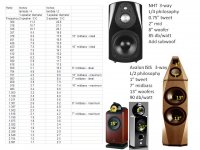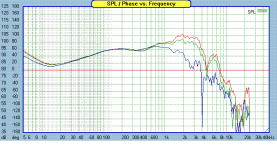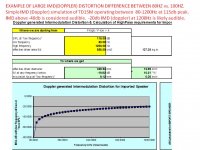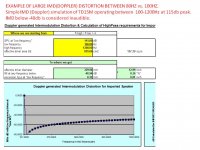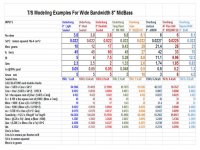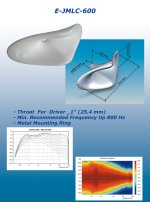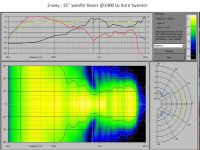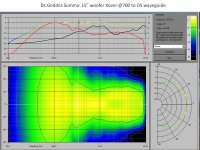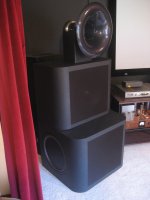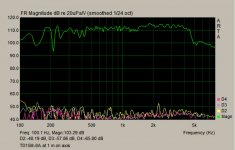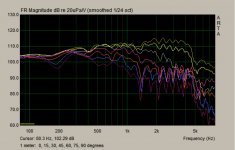Hi guys.
So i need a little advice here!
I'm putting together what is supposed to be my last speaker
One important criteria:
I would keep it down to a 3-way.
I'm a little confused about the choise of driver size. Some of you guys are prefering smaller drivers in the midrange, 10" at largest, arguing that larger format drivers, say 15," are not articulate enough, or lack the transient response of the smaller drivers.
Have any of you made a direct comparison between an 8" or 10" vs a 15" in the range up to ~1000Hz.
When i say a 3-way I mean in a sence that I would like the midrange driver to cover 100-1000Hz, crossing over to a pair of tapped horns (~30-100Hz). The awesome Beyma TPL 150 will be doing the high frequency duties.
The candidates are; Jbl 2123, PHL 3451; 18-sound NDA520, AE TD15M.
I know that both 10" dont go anywhere near 100Hz, but is it to much of a comprimise (soundwise) chosing the larger drives to gain the low end extension, thus crossing lower?
Thanks, Thomas
So i need a little advice here!
I'm putting together what is supposed to be my last speaker
One important criteria:
I would keep it down to a 3-way.
I'm a little confused about the choise of driver size. Some of you guys are prefering smaller drivers in the midrange, 10" at largest, arguing that larger format drivers, say 15," are not articulate enough, or lack the transient response of the smaller drivers.
Have any of you made a direct comparison between an 8" or 10" vs a 15" in the range up to ~1000Hz.
When i say a 3-way I mean in a sence that I would like the midrange driver to cover 100-1000Hz, crossing over to a pair of tapped horns (~30-100Hz). The awesome Beyma TPL 150 will be doing the high frequency duties.
The candidates are; Jbl 2123, PHL 3451; 18-sound NDA520, AE TD15M.
I know that both 10" dont go anywhere near 100Hz, but is it to much of a comprimise (soundwise) chosing the larger drives to gain the low end extension, thus crossing lower?
Thanks, Thomas
The main advantage of smaller drivers is they have wider dispersion such that the frequency response is consistent over a wider range of angles at high frequencies in comparison to a larger driver. You should decide the driver size based upon the polar response you desire, if you are going for a constant directivity (or at least smoothly varying) you should match the directivity of the mid and the tweeter at the crossover frequency. This will result in only one size of driver been suitable (assuming that its behaving as an ideal piston...). The more traditional aproach is just to go for wide dispersion and not attempt to match directivity so you would end up using an 8" mid or smaller.
The larger mids have the additional advantage of smaller excursion for a given SPL which (usualy) results in lower distortion. A speaker such as the Abbey:
Abbey
uses a large midbass and attempts match directivity at the crossover point. You can see from the directivity sonogram that the directivity smoothly narrows throughout the speakers range.
The larger mids have the additional advantage of smaller excursion for a given SPL which (usualy) results in lower distortion. A speaker such as the Abbey:
Abbey
uses a large midbass and attempts match directivity at the crossover point. You can see from the directivity sonogram that the directivity smoothly narrows throughout the speakers range.
Thanks kipman.
I'm actually leaning towards the TD15M from its reputaion. I'm horn loading the beyma with a 30x80 CD horn.
A 15" has an effevtive diameter of ~12.5" which lands the 80 degress dispersion at:
1*10^6/12.5/80 = 1000Hz
I've been told that the TD15M, due to the shape of the cone and the phase plug, this increases its dispersion caracteristics some 10%. As I'm aming for a 1200Hz x-over, this could be a match made in heaven.
-Thomas
I'm actually leaning towards the TD15M from its reputaion. I'm horn loading the beyma with a 30x80 CD horn.
A 15" has an effevtive diameter of ~12.5" which lands the 80 degress dispersion at:
1*10^6/12.5/80 = 1000Hz
I've been told that the TD15M, due to the shape of the cone and the phase plug, this increases its dispersion caracteristics some 10%. As I'm aming for a 1200Hz x-over, this could be a match made in heaven.
-Thomas
Last edited:
1/4 wl Gives you effectively co-ncident drivers and is a laudable goal. 1/2 w/l would be considered a maximum, but given typical driver selection that is relaxed to 1 w/l to give a chance -- a lot of people don't get near that even. In my last multiway i did meet the 1/4 wl criteria, but that was an MTM with 3" mid-tweet, 2x6.5" at ~350 Hz.
dave
dave
I favor 3-way speakers with an 8" to 10" midbass that covers 80-100 Hz to 1000-1400 Hz with a goal of staying under the lambda/2 maximum C-to-C spacing rule. My ears like the coherence and common timbre achieved from keeping the vocal range on one driver. To stay under lambda/4 C-C spacing would likely require a 4-way design to cover 20-20K Hz with low IMD(dopler).
Like Dr. Geddes' Summa speaker with its 700Hz Xover between the 15" woofer and OS waveguide for a correct polar response, I cross my Lambda TD15M speakers with LR4 slopes at ~700Hz to control beaming. Lambda TD10M cross LR4 at 1000 Hz. Tang Band W8-1808 8" cross LR4 at 1400 Hz.
Can a 0.02g Mms ribbon tweeter "perfectly blend" at 1,200Hz with a 70g Mms TD15M midbass?
0.02g Mms, Ribbon tweeter, 98db/watt, 1,600Hz Xover
0.45g Mms, silk dome tweeter, 94db/watt, 1,400Hz Xover
8.1g Mms, Lambda TD6M midrange, 93.5db/watt, 300-2,000Hz Xover
9.3g Mms, Tang Band W8-1808 midbass, 94db/watt, 100-1,400Hx Xover
44g Mms, Lambda TD10M midbass, 94db/watt, 80-1,000Hz Xover
70g Mms, Lambda TD15M(Overhung) midbass, 97.8db/watt, 80-700Hz Xover
104g Mms, Lambda TD15S woofer, 94db/watt, 25-700Hz Xover
Like Dr. Geddes' Summa speaker with its 700Hz Xover between the 15" woofer and OS waveguide for a correct polar response, I cross my Lambda TD15M speakers with LR4 slopes at ~700Hz to control beaming. Lambda TD10M cross LR4 at 1000 Hz. Tang Band W8-1808 8" cross LR4 at 1400 Hz.
Can a 0.02g Mms ribbon tweeter "perfectly blend" at 1,200Hz with a 70g Mms TD15M midbass?
0.02g Mms, Ribbon tweeter, 98db/watt, 1,600Hz Xover
0.45g Mms, silk dome tweeter, 94db/watt, 1,400Hz Xover
8.1g Mms, Lambda TD6M midrange, 93.5db/watt, 300-2,000Hz Xover
9.3g Mms, Tang Band W8-1808 midbass, 94db/watt, 100-1,400Hx Xover
44g Mms, Lambda TD10M midbass, 94db/watt, 80-1,000Hz Xover
70g Mms, Lambda TD15M(Overhung) midbass, 97.8db/watt, 80-700Hz Xover
104g Mms, Lambda TD15S woofer, 94db/watt, 25-700Hz Xover
Attachments
Have you considered using one of John's 12" drivers vs the 15" ? Might be a better match.Thanks kipman.
I'm actually leaning towards the TD15M from its reputaion. I'm horn loading the beyma with a 30x80 CD horn.
A 15" has an effevtive diameter of ~12.5" which lands the 80 degress dispersion at:
1*10^6/12.5/80 = 1000Hz
I've been told that the TD15M, due to the shape of the cone and the phase plug, this increases its dispersion caracteristics some 10%. As I'm aming for a 1200Hz x-over, this could be a match made in heaven.
-Thomas
I'm a little confused about the choise of driver size. Some of you guys are prefering smaller drivers in the midrange, 10" at largest, arguing that larger format drivers, say 15," are not articulate enough, or lack the transient response of the smaller drivers.
Transient Response, as it's commonly "imagined" has nothing to do with the size of the driver.
However, a larger driver will inevitibly have cone breakup at a lower frequency, which will smear details and in many cases cause harshness. As long as the driver is sufficiently down in level (~24 to ~40+ db) by this point, you're good.
When i say a 3-way I mean in a sence that I would like the midrange driver to cover 100-1000Hz, crossing over to a pair of tapped horns (~30-100Hz). The awesome Beyma TPL 150 will be doing the high frequency duties.
Up to 1khz? I'd probably be more comfortable with an 8" or 10" rather than a 12" or 15" cone. I think it will also have a better time of mating to the TPL-150's off-axis response. I know you pointed out that the 15" will be 80 degrees at that frequency, but that doesn't mean the TPL will, even if it's an 80 degree horn. It will lose directivity control higher than that most likely. Perhaps measure the polars to know what you're working with.
I know that both 10" dont go anywhere near 100Hz, but is it to much of a comprimise (soundwise) chosing the larger drives to gain the low end extension, thus crossing lower?
I think you DO want more lower bandwidth in this scenario, because tapped horns lack it.
Consider a Seas W26 Nextel FWIW. Maybe roll in a second actively for baffle step.
Also consider using a transmission line or port/ML-TL instead of going sealed. You won't lose anything audible in transient response, and you'll get a nice boost in extension. Bigger box, though.
Last edited:
I'm putting together what is supposed to be my last speaker.......crossing over to a pair of tapped horns (~30-100Hz). Thanks, Thomas
Dr. Earl Geddes white paper on room modes is a real page turner! With today's digital software crossovers and equalization it is easy to equalize the bass impulse response measured at the listener position, but you cannot equalize room modes. Room modes B nasty. Dr. Geddes recommends adding multiple woofers thoughtfully placed around the room to smooth out the deep bass room modes. Sealed woofers are easier to electronically equalize, and the 6db/octave bass fall-off is a close match to the 6db/octave bass gain from a typical room. A few well respected speaker manufactures now sell a "swarm" of sealed woofers with room mode modeling software to optimize placement.
Can I interest you in a few 15" or 18" sealed woofers? There are great 99db/watt woofers.
If you have the space, there is also some love for Push-Pull-Slot-Loaded sealed woofers which used counter-force to remove vibration and "spit" deep bass from a front slot. The TPL150H tweeter pleated diaphragm "spits", but from different physics.
Wayne at pispeakers.com also has a white paper declaring his love for corner speakers, showing how corner placement increases efficiency, widens the sweet spot, and reduces room modes. You do not need corner horns ala Klipsch, and can get corner benefits from sealed bass woofers + sealed 10" midbass + TPL150H. You get a 90 degree polar response across the full frequency range.
A few alternatives to tapped horns.
One More Thing.
Simple models for IMD (doppler) distortion show a large increase in the 3-way midbass IMD when the bass crossover frequency moves below 100Hz. An 8" midbass is capable of 100Hz to 1300-1400Hz with good efficiency, low IMD, plus a successful marriage to a quality tweeter. A 10" midbass would favor a 1000 Hz Xover to stay under M-to-T less than lambda/2 C-to-C spacing, which requires a "robust" tweeter plus some directivity control(horn). A 15" midbass would favor a 700-800 Hz Xover, but would still require a 95-100 Hz lower Xover frequency to maintain -40db IMD margins.
You will find several TD15M midbass diy_posts where the TD15M is crossed 700-800 Hz to a 1" to 2" compression driver plus horn. If you want the sound of the TD15M from 100Hz to 700-800Hz, you may want to research 1" - 1.4" compression drivers and cool looking horns.
Simple models for IMD (doppler) distortion show a large increase in the 3-way midbass IMD when the bass crossover frequency moves below 100Hz. An 8" midbass is capable of 100Hz to 1300-1400Hz with good efficiency, low IMD, plus a successful marriage to a quality tweeter. A 10" midbass would favor a 1000 Hz Xover to stay under M-to-T less than lambda/2 C-to-C spacing, which requires a "robust" tweeter plus some directivity control(horn). A 15" midbass would favor a 700-800 Hz Xover, but would still require a 95-100 Hz lower Xover frequency to maintain -40db IMD margins.
You will find several TD15M midbass diy_posts where the TD15M is crossed 700-800 Hz to a 1" to 2" compression driver plus horn. If you want the sound of the TD15M from 100Hz to 700-800Hz, you may want to research 1" - 1.4" compression drivers and cool looking horns.
Attachments
Having done 2 and 3 ways in this mould, I think you are making a mistake not taking it to a 4 way.Hi guys.
So i need a little advice here!
I'm putting together what is supposed to be my last speaker
One important criteria:
I would keep it down to a 3-way.
I've used the 2123 extensively, tried the 2220/5/6 up to 1khz, and heard the PHL (in a 4 way) and the TD15M in a 2 way with a QSC 152 WG. I wouldn't use the JBL or PHL 10" in a 2 way and of the others, only the TD15M struck me as good enough. But still not my choice.I'm a little confused about the choise of driver size. Some of you guys are prefering smaller drivers in the midrange, 10" at largest, arguing that larger format drivers, say 15," are not articulate enough, or lack the transient response of the smaller drivers.
Have any of you made a direct comparison between an 8" or 10" vs a 15" in the range up to ~1000Hz.
When i say a 3-way I mean in a sence that I would like the midrange driver to cover 100-1000Hz, crossing over to a pair of tapped horns (~30-100Hz). The awesome Beyma TPL 150 will be doing the high frequency duties.
The candidates are; Jbl 2123, PHL 3451; 18-sound NDA520, AE TD15M.
I know that both 10" dont go anywhere near 100Hz, but is it to much of a comprimise (soundwise) chosing the larger drives to gain the low end extension, thus crossing lower?
Thanks, Thomas
With the TPL150H, you'd be closer to my preference.
Hi guys!
Thanks to all!
I've gotton so many replies to my tread already, so I'll just reply in plenum - hope its okay.
In regard to center-center spacing, Whayne (pi-Speakers) shares his knowlegde on the subject:
http://www.pispeakers.com/Pi_Speakers_Info.pdf.
I have actually built the 7pi some years back, the midrange horn was pretty time consuming.
I don't know how fx a 15" mates to the ribbon at ~1000Hz (mass-wise)
I'm building the Beyma horn flare my self, its cheaper and I can chop wood too
Looks like dispersion adds up pretty nicely at around 1200Hz, looking at the Beyma H-version:
http://profesional.beyma.com/ingles/pdf/TPL150H.pdf
-Thomas
Thanks to all!
I've gotton so many replies to my tread already, so I'll just reply in plenum - hope its okay.
In regard to center-center spacing, Whayne (pi-Speakers) shares his knowlegde on the subject:
http://www.pispeakers.com/Pi_Speakers_Info.pdf.
I have actually built the 7pi some years back, the midrange horn was pretty time consuming.
I don't know how fx a 15" mates to the ribbon at ~1000Hz (mass-wise)
I'm building the Beyma horn flare my self, its cheaper and I can chop wood too
Looks like dispersion adds up pretty nicely at around 1200Hz, looking at the Beyma H-version:
http://profesional.beyma.com/ingles/pdf/TPL150H.pdf
-Thomas
In regard to center-center spacing, Wayne (pi-Speakers) shares his knowlegde on the subject:
Looks like dispersion adds up pretty nicely at around 1200Hz, looking at the Beyma H-version-Thomas
Geddes and JohnK have developed excellent polar response modeling tools. Looking at plots of a 15" midbass crossed to a horn at 700Hz shows better polar response, better controlled directivity, and better constant power than plots of a 15" midbass crossed to a horn at 1400Hz. JohnK likes to paint a picture of many point sources across the entire radiating area ... 15" woofer + TPL150 HEIL ... and understand how vibrating points separated by distances equal to wavelength mutliples will cancel and result in a nasty polar response and uneven power delivery to the listeners.
"I'm putting together what is supposed to be my last speaker." Simulation is good insurance when designing an expensive unique last speaker.
Attachments
Geddes and JohnK have developed excellent polar response modeling tools. Looking at plots of a 15" midbass crossed to a horn at 700Hz shows better polar response, better controlled directivity, and better constant power than plots of a 15" midbass crossed to a horn at 1400Hz. JohnK likes to paint a picture of many point sources across the entire radiating area ... 15" woofer + TPL150 HEIL ... and understand how vibrating points separated by distances equal to wavelength mutliples will cancel and result in a nasty polar response and uneven power delivery to the listeners.
If I'm lucky I can get the Beyma to reach 800Hz. I have friend doing some experiments in that range.
Regarding the Eminence DE250 crossing to a woofer at 700Hz gaining the desired response - I'm sure its possible. Still, making the DE250 sound as good as the Beyma, despite its lower x-over capabilities, is never gonna happen. Having built the 7pi (DE250) it is a fine compression driver, but the Beyma TPL is hole different animal - I promise!
If I'm lucky I can get the Beyma to reach 800Hz. - I promise!
Everyone will appreciate your TPL150+custom_waveguide trailblazing. I normally mount my midbass and tweeter onto a junk refrigerator cardboard box and perform a few measurements, including using square waves to measure the time delay between the two drivers at the crossover frequency. It would be a nice coincidence if the depth of your custom wood waveguide matched the time delay between the TPL150 and TD15M. It will be interesting to see if you decide upon a 90x40 or more controlled 60x40 to better match the TD15M at 700-800Hz.
Gary Dahl performed many measurements on the TD15M which would be easy to seach and review. Gary taught me that very large cabinet edge round-overs on all front and rear edges are necessary for the best measured response. I purchased a 1.5" quater round router bit. Gary uses custom MDF 3" rounds. Gary is a golden ear conductor!
There are several well reviewed JAES papers which show how bass over 60Hz is directional. This is one reaon a 3-way single box with a large sealed 18" - 21" woofer per speaker matches my education. Perhaps the TPL150 waveguide could be rubber band shock mounted in the woofer + midbass cabinet.
Attachments
Everyone will appreciate your TPL150+custom_waveguide trailblazing. I normally mount my midbass and tweeter onto a junk refrigerator cardboard box and perform a few measurements, including using square waves to measure the time delay between the two drivers at the crossover frequency. It would be a nice coincidence if the depth of your custom wood waveguide matched the time delay between the TPL150 and TD15M. It will be interesting to see if you decide upon a 90x40 or more controlled 60x40 to better match the TD15M at 700-800Hz.
Gary Dahl performed many measurements on the TD15M which would be easy to seach and review. Gary taught me that very large cabinet edge round-overs on all front and rear edges are necessary for the best measured response. I purchased a 1.5" quater round router bit. Gary uses custom MDF 3" rounds. Gary is a golden ear conductor!
There are several well reviewed JAES papers which show how bass over 60Hz is directional. This is one reaon a 3-way single box with a large sealed 18" - 21" woofer per speaker matches my education. Perhaps the TPL150 waveguide could be rubber band shock mounted in the woofer + midbass cabinet.
LineSource:
Thanks!
Is it your or Garys' system in the pics - looks awesome!
I just doug out an old rough measurement I've made of the Beyma in the original H-horn. I dont think a larger horn will bring it much lower - with benefit!
Crossing the Beyma at 1200-1500Hz is more optimistic!
I have the chance to buy a pair of PHL 3451 for about ½ of what the TD15M is gonna cost with shipping and taxes ect...
In this frequency range the dispersion of the 10" will match the Beyma better anyway and going 3-way, single speaker, I can add an 18" below 200 cycles.
Thoughts?
Attachments
- Status
- This old topic is closed. If you want to reopen this topic, contact a moderator using the "Report Post" button.
- Home
- Loudspeakers
- Multi-Way
- large format midrange driver or...
